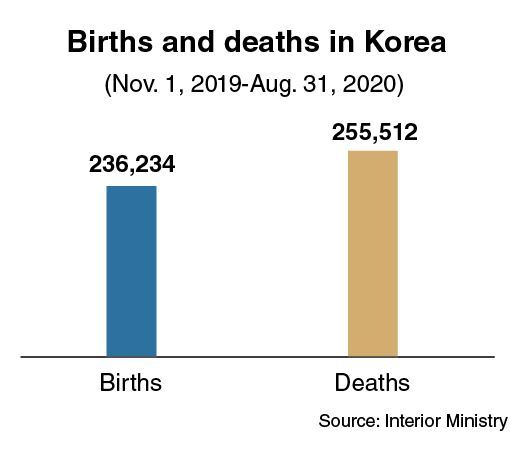[News Focus] Korea sees births hit record-low in August
Deaths outnumber births for 10 consecutive months
By Kim Yon-sePublished : Sept. 6, 2020 - 16:26

SEJONG -- South Korea posted 21,960 in the number of births in August, which marked a record low since the government began compiling the data on a monthly basis.
It is also the first time that the monthly figure for newborns fell below the 22,000 mark, the data from the Ministry of Interior and Safety showed.
The figure for August 2020 contrasts with 31,291, posted three years earlier in August 2017 and 35,868, five years earlier in August 2015.
Further, Korea saw the number of deaths outstrip that of births for the 10th consecutive month since November 2019. This was also unprecedented.
In August, the nation’s deaths outnumbered births by 1,933, according the Interior Ministry.
The situation has continued over the past 10 months. During the November 2019-August 2020 period, the deaths outnumbered the births by 19,278 (255,512 vs. 236,234) on a cumulative basis.

This might indicate an “arithmetical” decline in population of 19,278 for the past 10 months. But immigration and citizenship changes have somewhat offset the decrease, leaving it at 10,752.
The demographic changes reflect citizenship changes (Koreans renouncing their citizenship and those acquiring Korean citizenship) or the long-term resident status of Koreans overseas and foreigners here.
Despite the offset, the data showed that Korea’s population has been shrinking since late 2019.
Though the figure bounced back in July (by 444) and August (by 101), the population decreased by 12,019 collectively between Dec. 1, 2019 and June 30, 2020.
Last month, some major cities and provinces suffered a continual losing streak in the number of registered residents.
Seoul topped the list the decline ranking among the 17 major areas (eight cities and nine provinces) as the capital posted minus 7,182. The population of Seoul stood at 9.708 million, which is the lowest since the mid-1980s.
Some households in Seoul have moved to Gyeonggi Province due to skyrocketing apartment prices over the past several years.
In the five-months from March 1 to July 31 alone, the number of residents in the capital decreased by 28,715. Compared to five years earlier in July, Seoul’s population is down about 360,000.
North Gyeongsang Province ranked second in the monthly population decline, where it was 3,069, followed by South Gyeongsang Province with 2,468, Incheon with 2,074, Busan with 1,704 and South Jeolla Province with 1,354.
A seriousness in the demographic structure is the rapid climb in the proportion of seniors.
The tally for those aged 70 or over came to 5.64 million, which made up 10.8 percent of the entire population, 51.83 million.
While those aged 60 or over posted 12.23 million, those aged 50 or over reached 20.88 million last month.
When it comes to those aged 65 or over (the seniors stipulated by the United Nations), the age group posted 8.35 million, or 16.1 percent of the population.
This contrasts with the youth aged under 15. The percentage of people aged between zero and 14 stood at 12.3 percent (6.36 million).
By Kim Yon-se (kys@heraldcorp.com)







![[Graphic News] More Koreans say they plan long-distance trips this year](http://res.heraldm.com/phpwas/restmb_idxmake.php?idx=644&simg=/content/image/2024/04/17/20240417050828_0.gif&u=)
![[KH Explains] Hyundai's full hybrid edge to pay off amid slow transition to pure EVs](http://res.heraldm.com/phpwas/restmb_idxmake.php?idx=644&simg=/content/image/2024/04/18/20240418050645_0.jpg&u=20240419100350)





![[From the Scene] Monks, Buddhists hail return of remains of Buddhas](http://res.heraldm.com/phpwas/restmb_idxmake.php?idx=652&simg=/content/image/2024/04/19/20240419050617_0.jpg&u=20240419175937)

![[KH Explains] Hyundai's full hybrid edge to pay off amid slow transition to pure EVs](http://res.heraldm.com/phpwas/restmb_idxmake.php?idx=652&simg=/content/image/2024/04/18/20240418050645_0.jpg&u=20240419100350)

![[Today’s K-pop] Illit drops debut single remix](http://res.heraldm.com/phpwas/restmb_idxmake.php?idx=642&simg=/content/image/2024/04/19/20240419050612_0.jpg&u=)